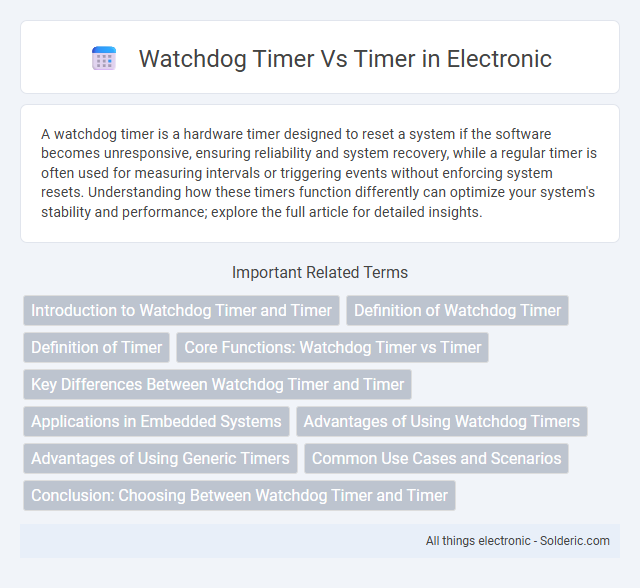A watchdog timer is a hardware timer designed to reset a system if the software becomes unresponsive, ensuring reliability and system recovery, while a regular timer is often used for measuring intervals or triggering events without enforcing system resets. Understanding how these timers function differently can optimize your system's stability and performance; explore the full article for detailed insights.
Comparison Table
| Feature | Watchdog Timer | Timer |
|---|---|---|
| Purpose | System fault detection and recovery | Event timing and scheduling |
| Function | Resets system on software failure or hang | Generates delays, intervals, or periodic interrupts |
| Operation | Monitors system activity with timeout counter | Counts clock pulses for time measurement |
| Use Case | Embedded system reliability and safety | General-purpose time management |
| Activation | Automatic system reset if not refreshed | Triggered manually or automatically for timing events |
| Hardware Integration | Typically hardware module in microcontrollers | Common peripheral in microcontrollers and timers |
| Key Data | Timeout period, reset signal | Count value, prescaler, interrupt |
Introduction to Watchdog Timer and Timer
A Watchdog Timer is a specialized hardware timer designed to automatically reset a system if the software becomes unresponsive, ensuring system reliability and preventing crashes. In contrast, a Timer is a general-purpose hardware or software component used to measure time intervals, generate delays, or trigger events at specified intervals within an application. Both devices play crucial roles in embedded systems, but the Watchdog Timer primarily focuses on system safety, while the Timer facilitates timing and scheduling functions.
Definition of Watchdog Timer
A Watchdog Timer is a specialized hardware timer designed to detect and recover from malfunctions by resetting the system if it becomes unresponsive, ensuring reliable operation. Unlike a regular Timer, which measures elapsed time or schedules tasks, a Watchdog Timer continuously monitors system activity and triggers a reset when software fails to clear or "kick" the timer within a set period. Your embedded systems benefit from Watchdog Timers by preventing crashes and maintaining stability during unexpected software failures.
Definition of Timer
A timer is a hardware or software component that measures time intervals and triggers events after a specified period, commonly used in embedded systems for scheduling tasks or generating delays. A watchdog timer is a specialized timer designed to reset the system if the software fails to operate correctly within a set timeframe, improving system reliability. Understanding the definition of a timer helps you differentiate its general purpose from the watchdog timer's role in system fault detection.
Core Functions: Watchdog Timer vs Timer
A Watchdog Timer primarily functions as a system safety mechanism that resets the system if software anomalies occur, ensuring reliable operation by monitoring system activity. In contrast, a Timer is designed for measuring time intervals, generating precise delays, or triggering events at set time periods within embedded systems. While the Timer facilitates task scheduling and event timing, the Watchdog Timer ensures fault tolerance by detecting and recovering from system hangs or failures.
Key Differences Between Watchdog Timer and Timer
A Watchdog timer monitors system operation to detect and recover from malfunctions by triggering a system reset when the timer is not regularly refreshed, ensuring system reliability. In contrast, a Timer generates precise time delays or measures elapsed time for various tasks without inherently managing system failure states. The key difference lies in the Watchdog timer's role in fault detection and recovery, while the Timer primarily functions for timing and event scheduling.
Applications in Embedded Systems
Watchdog timers are crucial in embedded systems for ensuring system reliability by resetting the device during software malfunctions or hang-ups, commonly used in safety-critical applications like automotive and industrial controls. Standard timers primarily handle time-based operations such as generating delays, measuring intervals, or triggering periodic events in applications like motor control and sensor polling. Your embedded system benefits from integrating both, where watchdog timers provide fault tolerance and timers facilitate precise operation scheduling.
Advantages of Using Watchdog Timers
Watchdog timers provide a critical advantage in embedded systems by automatically resetting the system when it becomes unresponsive, thereby enhancing reliability and preventing system crashes. Unlike regular timers that only measure time intervals, watchdog timers actively monitor system health and ensure continuous operation without manual intervention. Incorporating a watchdog timer in your design helps safeguard against software hangs and unexpected faults, improving overall system stability and robustness.
Advantages of Using Generic Timers
Generic timers offer greater flexibility in embedded systems by providing multiple modes such as one-shot, periodic, and pulse generation, enabling precise control tailored to diverse applications. You benefit from enhanced configurability, including adjustable prescalers and interrupt capabilities, which improve system responsiveness and reduce processor load. Compared to watchdog timers that primarily ensure system recovery, generic timers deliver broader functionality for timing and event scheduling tasks.
Common Use Cases and Scenarios
Watchdog timers are primarily used in embedded systems to detect and recover from software malfunctions by resetting the system if timely signals are not received, ensuring reliability in critical applications like automotive controllers and industrial machines. Standard timers, on the other hand, facilitate event scheduling, time delays, and periodic task management in applications such as real-time operating systems, user interfaces, and communication protocols. Both components are essential for maintaining system stability and precise timing control, but watchdog timers specifically enhance fault tolerance in environments requiring high uptime.
Conclusion: Choosing Between Watchdog Timer and Timer
Choosing between a Watchdog timer and a Timer depends on your system's reliability requirements versus general timing needs. Watchdog timers are essential for automatic system recovery by detecting and responding to failures, while timers primarily handle precise time-based events or delays. Your decision should prioritize fault tolerance with a Watchdog timer or event scheduling accuracy with a Timer.
Watchdog timer vs Timer Infographic

 solderic.com
solderic.com